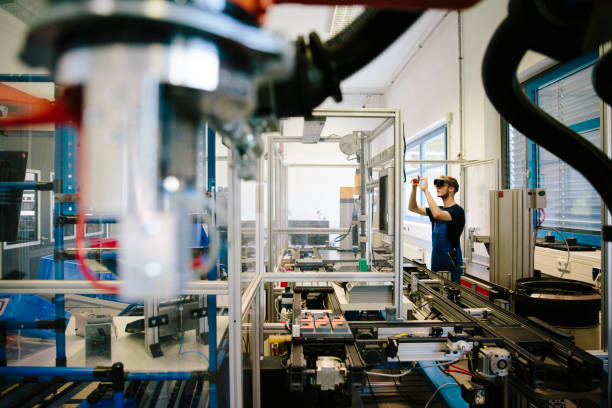THE BEST APPLICATIONS OF AR FOR MANUFACTURING IN 2022


Augmented reality (AR) is changing the manufacturing industry. As reported by ABI research, the market value of industrial AR is estimated to hit $70 billion by 2025.
Improvements in AR technology are narrowing the gap between the real and virtual worlds, exposing us to a new realm of exciting opportunities.
But first, let’s define AR and differentiate it from virtual reality (VR).
AR refers to the integration of digital elements into real-world environments. While VR consists of entirely-computer generated domains, AR applies computer-generated information to our natural environment.
By overlaying sensory information (sounds, graphics, etc.) on natural habitats, AR can enhance our perception of the world. The popular mobile game Pokemon GO is an excellent example of how AR is used and how it varies from VR.
However, the scope of AR extends far beyond mobile games and entertainment. AR in manufacturing is one example of this idea.
Three types of AR are currently used in manufacturing:
- TABLET AR
Tablet AR mainly consists of tablets and other handheld devices that provide instructions through apps.
- WEARABLE AR
The wearable AR category includes hands-free devices like headsets and glasses that can apply sensory information to the user’s environment.
- PROJECTED AR
Projected AR refers to devices that can display interactive graphics onto surfaces. Projected AR is quite dynamic and can be used for various issues on the manufacturing floor.
AR in manufacturing has many applications, some of which are discussed below.
DATA ACCESS
AR simplifies managing data and information such as user guides and manuals. These need to be accessible, but it is difficult to organize them in such a way.
With AR in manufacturing, this categorization process is effortless, so you have instant access to all necessary information. This dramatically increases productivity and decreases downtime.
REMOTE EXPERTISE
At any large-scale manufacturing venture, equipment failure is bound to occur. The use of AR in manufacturing encourages efficient troubleshooting and repair action by allowing engineers and experts from all across the globe rapid access to the site.
This way, the issues can be diagnosed and resolved quickly and effectively. AR in the manufacturing industry would significantly cut the time, effort, and cost associated with such problems.
ENSURING SAFETY
AR in manufacturing allows the factory owners, clients, and officials, to take virtual tours of the site to ensure compliance with regulatory requirements. AR tools could also be used to detect possible hazards and malfunctions.
Combined with the rapid access to experts discussed above, AR in manufacturing can significantly strengthen the safety standards of factories.
EFFECTIVE TRAINING
Training efficacy and knowledge retention can also be increased by using AR in manufacturing. AR makes on-the-spot training more accessible and cost-effective as experts can provide their guidance remotely.
It also facilitates experience-based learning complemented by 3D models and other visual elements that aid understanding and retention. Progress can also be monitored effectively.
RESEARCH AND DESIGN
With AR technology in manufacturing, the creative research and design process can become more effective as the technology reduces the time and effort required to create physical prototypes and revise them. This fuels innovation and collaboration and eliminates some of the most strenuous parts of the research and design process.
These are only a few of how AR is successfully implemented in the manufacturing industry. The bottom line is that AR in manufacturing boosts productivity, performance, efficiency, and safety while reducing overall costs. In addition, with the growing labor shortage in the industry, AR in manufacturing is integral to building a future workforce.
Sketch AR
SketchAR can be used to bring out the artist. AR-enabled apps can now assist individuals in drawing more accurately. SketchAR enables people to unlock their artistic potential digitally.
The combination of high-performance computing, augmented reality, and artificial intelligence is fantastic. You’ll need two technology art phones and paper.
When you open your SketchAR camera, you will see virtual lines on the form. Grab a pencil and draw along the lines. Specifically, use AR to transform photos into art.
SketchAR users can also monetize their artwork and become a part of a larger community (more than 8 million creators).


CONCLUSION
In manufacturing, augmented reality (AR) transforms how we connect and engage. Augmented reality is a blend of digital and audiovisual elements that combines the physical and digital worlds. In contrast to virtual reality (VR), augmented reality (AR) permits interaction between computer-generated information and the actual environment. VR disconnects users from reality by using headsets to block their perception of virtual reality. AR, on the other hand, aligns the two. Whether it’s a Pokémon on the sidewalk, a new chair in your office, or guiding work instructions on your workstation, these displays incorporate a new reality into our existing one. AR improves production capabilities when used together, making it an ideal tool for Industry 4.0.
Realtime AR is the APAC gold channel partner and distributor of RealWear and Moziware AR wearable devices. We are offering hardware, software, and training for your organization.
For more information Visit us here.

